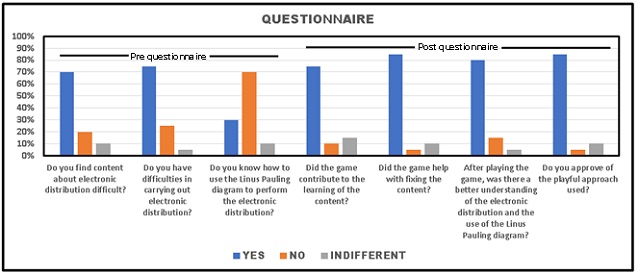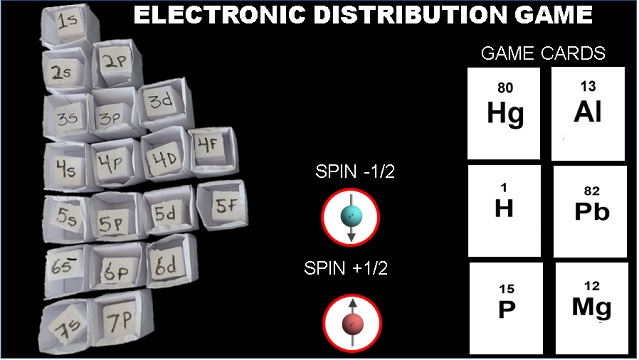Autores
Silva, F.P. (IFTO CAMPUS PARAÍSO DO TOCANTINS) ; Viroli, S.L. (IFTO CAMPUS PARAÍSO DO TOCANTINS) ; Ramos, M.L. (IFTO CAMPUS PARAÍSO DO TOCANTINS) ; Lança, A.C. (IFTO CAMPUS PARAÍSO DO TOCANTINS) ; Alves, T.T. (UFT CAMPUS GURUPI) ; Queiroz, E.M.G. (ESCOLA ESTADUAL PROFESSORA RITA) ; Carvalho, N.P. (IFTO CAMPUS PARAÍSO DO TOCANTINS)
Resumo
Games applied to teaching chemistry can become an excellent pedagogical strategy
in content with learning difficulties. The objective of this work was to apply a
didactic learning object to help the teaching-learning process about electronic
distributions and the use of the Linus Pauling diagram. The game was applied to
students in the MB class 23.04 at CEM Rui Brasil Cavalcante. After the game, a
questionnaire was applied. According to the results, students considered the
content on electronic distribution difficult, and had difficulties in performing
electronic distribution and did not know how to use the Linus Pauling diagram.
The playful activity developed promoted teaching and learning, minimizing the
difficulty in performing the electronic distribution using the Linus diagram.
Palavras chaves
Chemistry teaching; quantum numbers; chemical element
Introdução
Chemistry is seen by most students as a difficult, abstract subject, without
social application, monotonous, generating demotivation, lack of attention and
concentration of students. (FERREIRA et al., 2019; FERNANDES et al., 2019). Some
school environments contribute to distance chemistry from students due to poor
teaching with memorization of content, formulas, laws and mechanical resolutions
of exercises, making it impossible to develop meaningful learning (CRISÓSTOMO et
al, 2018). One possibility of reversing this context is the use of an
alternative and innovative methodology (OLIVEIRA et al, 2018). Many didactic
processes were developed to facilitate the teaching and learning of chemistry
content in high school (PESSOA; PAZ; LIMA, 2013). The playful application has
been approached in the classroom to help teachers in their pedagogical
practices, as these resources attract the student's attention, stimulating
interest in the content taught (CASTRO; DIONIZIO; SILVA, 2015; OLIVEIRA; SOARES;
VAZ, W, 2015). Games applied to chemistry teaching can become an excellent
pedagogical strategy, providing an engaging environment, with the acquisition of
various skills, becoming a possibility to enhance student performance in content
with learning difficulties (LEÃO et al, 2019). Therefore, the teacher can adapt
the syllabus to the game, collaborating with the student in carrying out
activities of abstraction and reformulation of conceptions, stimulating and
establishing knowledge to a new communicated explanation (ZANON; GUERREIRO;
OLIVERIA, 2008). This work aims to apply a didactic learning object with the
intention of helping the teaching-learning process in the classroom about
electronic distributions using the Linus Pauling diagram.
Material e métodos
The game was developed and applied at the Rui Brasil Cavalcante High School
Center, located in the City of Miranorte, State of Tocantins, by 4 students in
the 2nd Bimester of 2022, to assist in understanding and fixing the content,
electronic distribution and Linus diagram. Pauling, exposed by the teacher in
the classroom. To make the game, a styrofoam sheet (50cm x 50cm x 1cm), a black
EVA sheet, 118 cards to represent the spins (+1/2 and -1/2), 118 cards (5cm x
4cm) containing the symbol, name and atomic number of the chemical element and
19 cubes (7cm x 7cm x 7 cm). The game was applied to 20 students from the 23.04
class. Students were divided into pairs and instructed on the rules of the game.
The game started with each student taking a card from the deck of cards and
starting to play. The student who removed the card with the highest atomic
number started the game by distributing the chips (spins +1/2 and -1/2) in the
cubes (sublevels s, p, d, f) as shown in figure 02. questionnaire applied before
and after the game. The application before the game served to assess students'
knowledge and contained the following questions do you consider the content
about electronic distribution difficult? Do you have difficulties in carrying
out electronic distribution? Do you know how to use the Linus Pauling diagram to
perform the electronic distribution? After the completion of the game, students
were asked to evaluate the methodology applied the following questions. Did the
game contribute to the learning of the content? Did the game help with fixing
the content? After playing the game, was there a better understanding of the
electronic distribution and the use of the Linus Pauling diagram? Do you approve
of the playful approach used?
Resultado e discussão
Graph 1 shows the answers to the pre and post questionnaire applied to students
in the 1st year of high school. Figure 2 represents the applied game. According
to the results observed in Graph 1, the pre-questionnaire showed that 70% of the
students considered the content on electronic distribution difficult, 75% had
difficulties in carrying out the electronic distribution and 70% did not know
how to use the Linus Pauling diagram to carry out the eletronic distribution.
Also according to Graph 1, the post-questionnaire showed that 75% considered
that the game contributed to the learning of the content, 85% said that the game
helped in fixing the content, 80% declared that after playing the game there was
better understanding of electronic distribution and use of the Linus Pauling
diagram and 85% approved the electronic distribution game. The playful approach
performed presented values equal to or greater than 75% in all questions asked
after the application of the game, evidencing a great acceptance and
contributing to a significant learning about the content of electronic
distribution using the Linus Pauling diagram, stimulating skills necessary for
educational practices, students' interest and information sharing among them,
motivating them and producing success in capturing the content taught in the
classroom. Santos et al. (2015), conducting a study with electronic distribution
using the Linus Pauling diagram, found that the great difficulty encountered by
students is in how to perform electronic distribution using the diagram and
after applying a playful activity 93% of the students interviewed claimed to
know how to perform it correctly the electronic distribution using the diagram
electronic distribution of chemical elements using the diagram.


Conclusões
The game on the Linus Pauling diagram evaluated by the students of the 1st Year
of Education in the class 23.04 of the Rui Brasil Cavalcante High School showed
satisfactory results, where all the items evaluated after the application of the
game presented values equal to or greater than 75% of approval. The data obtained
identified difficulties in performing the electronic distribution using the Linus
Pauling diagram. The playful activity developed promoted teaching and learning,
minimizing the difficulty in performing the electronic distribution using the
Linus diagram.
Agradecimentos
To God, to the IFTO Paraíso do Tocantins campus
Referências
CASTRO, D.L.; DIONIZIO, T.P.; SILVA, I. G. Na trilha dos elementos químicos: o ensino de Química através de uma atividade lúdica. Revista Brasileira de Ensino de Química, v. 10, n. 1, p. 46-58, 2015. Disponível em: https://issuu.com/atomoealinea/docs/rebeq_v10_n1. Acesso em 13 abr. 2022
CRISÓSTOMO, L. C. DA S.; MARINHO, M. M; MARINHO, G. S; MARINHO, E. S. Avaliação de um jogo pedagógico desenvolvido com o powerpoint para o ensino de química. 23º Seminário Internacional de Educação, Tecnologia e Sociedade. v. 7 n. 1. P. 1-10. 2018. Disponível em: https://seer.faccat.br/index.php/redin/article/view/1067. Acesso em 12 abr. 2022.
FERNANDES, G.S.; COSTA, A.N.S.; SILVA, J.P.; SILVA, A.N.; MELLO, T.; FANTINELL JÚNIOR, M.; LEÃO, M.F. Jogos didáticos como ferramenta que auxilia o ensino da tabela periódica para estudantes do 1º ano do ensino médio. In: CONGRESSO BRASILEIRO DE QUIMICA, 59., 2019, João Pessoa. Anais Eletrônicos [...]. João Pessoa, 2019. Disponível em: http://www.abq.org.br /cbq/2019/trabalhos/5/956-27759.html. Acesso em: 21 maio. 2022.
FERREIRA, J.F.; SANTOS, J.C.O.; FERREIRA, B.N.; FONSECA, L.L.S.A.; DANTAS, T.R.; AZEVEDO, A.S.; CARDOSO, M.L.M.S.; GARCIA, J.D.R.; ARAÚJO, J.V.S.; SANTOS, D. Utilização de jogos didáticos no ensino de funções orgânicas. In: CONGRESSO BRASILEIRO DE QUIMICA, 59., 2019, João Pessoa. Anais Eletrônicos [...]. João Pessoa, 2019. Disponível em: http://www.abq.org.br /cbq/2019/trabalhos/5/956-27759.html. Acesso em: 21 maio. 2022.
LEÃO, M.F.; FANTINELL JÚNIOR, M.; COSTA, A.N.S.; ALVES, A.C.T. Jogos didáticos no ensino de ciências: maneira diferenciada de ensinar e aprender sobre poluição. In: CONGRESSO BRASILEIRO DE QUIMICA, 59., 2019, João Pessoa. Anais Eletrônicos [...]. João Pessoa, 2019. Disponível em: http://www.abq.org.br /cbq/2019/trabalhos/5/956-27759.html. Acesso em: 21 maio. 2022.
OLIVEIRA, J. S.; SOARES, M. H. F. B.; VAZ, W. F. Banco Químico: um jogo de tabuleiro, cartas, dados, compras e vendas para o ensino do conceito de soluções. Química Nova na Escola, v. 37, n. 4, p. 285-293, 2015. Disponível em: http://qnesc.sbq.org.br/online/qnesc37_4/08-RSA-22-13.pdf. Acesso em: 13 maio 2022
OLIVEIRA, A. L.; OLIVEIRA, J. C. P. DE; NASSER, M. J. S.; CAVALCANTA, M. P. O jogo educativo como recurso interdisciplinar no ensino de química. Revista Química nova escola. vol. 40 nº 2, p.89-96. 2018. Disponível em: http://qnesc.sbq.org.br/online/qnesc40_2/05-RSA-82-16. Acesso em: 20 mar 2022.
PESSOA, D.C.S.; PAZ, W.H.P.; LIMA, F.C.A. Tabuleiro de Linus Paulling: um jogo inovador e criativo para o ensino de química. In: CONGRESSO BRASILEIRO DE QUIMICA, 53., 2013, Rio de Janeiro Anais Eletrônicos [...]. Rio de Janeiro, 2013. Disponível em: http://www.abq.org.br/cbq/2013/trabalhos/6/2754-16626.html. Acesso em: 21 maio. 2022.
Santos, J.M.S; Lima, N.H.Q.; Ferreira, L.S.M.; Silva, C.F. Aprendendo Distribuição Eletrônica Dos Elementos Químicos: O Lúdico Do Diagrama De LINUS PAULING. In: CONGRESSO BRASILEIRO DE QUIMICA, 55., 2015, Goiânia Anais Eletrônicos [...]. Goiânia, 2015. Disponível em: http://www.abq.org.br/cbq/2015/trabalhos/6/7666-18888.html. Acesso em: 18 maio. 2022
ZANON D.A.; GUERREIRO M. A.S; OLIVERIA R. C; Jogo didático Ludo Químico para o ensino de nomenclatura dos compostos orgânicos: projeto, produção, aplicação e avaliação Ciências & Cognição; Vol 13 (1): 72-81 2008. Disponivel em: http://www.cienciasecognicao.org/pdf/v13/cec_v13-1_m318239.pdf . Acesso em: 10 abr 2022
















